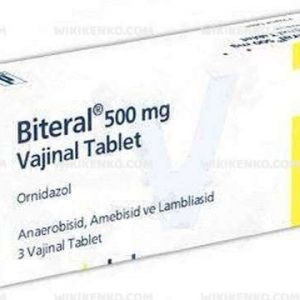Description
Benefits
Biteral finds extensive utility in the treatment of diverse medical conditions, making it a valuable asset in the realm of healthcare. Its primary benefits encompass the management of:
- Amoebiasis (Intestinal and Hepatic): Biteral is a valuable intervention against amoebic infections, which can affect the intestines and the liver.
- Giardiasis: Effective against Giardia infections, this medication assists in alleviating the symptoms associated with this parasitic condition.
- Trichomoniasis: Biteral contributes to the treatment of trichomoniasis, a sexually transmitted infection caused by Trichomonas vaginalis.
- Bacterial Vaginosis: It plays a pivotal role in combatting bacterial vaginosis, a common vaginal infection characterized by an imbalance of bacteria.
- Susceptible Anaerobic Infections: Biteral is a valuable therapeutic option for infections caused by anaerobic bacteria, demonstrating its versatility in combating a range of microbial challenges.
Uses
Beyond its primary applications, Biteral serves as an associated treatment for several other medical conditions, including:
- Amebiasis
- Anaerobic Bacterial Infection
- Chlamydial Infections
- Gastrointestinal Infections Caused by Entamoeba Histolytica
- Mixed Vaginal Infections
- Surgical Site Infections
- Trichomonal Vaginitis
- Trichomoniasis
Dosage
The appropriate dosage of Biteral depends on the specific medical condition being addressed:
| Condition | Adult Dosage | Pediatric Dosage (Children) |
|---|---|---|
| Amoebiasis | 500 mg twice daily for 5 days | 10-25 mg per kg of body weight, divided into two doses |
| Amoebic Dysentery | 1.5 gm once daily for 3 days | 40 mg per kg of body weight, once daily for 3 days |
| Giardiasis | 1.5 gm once daily for 1-2 days | 40 mg per kg of body weight for 2 days |
| Trichomoniasis | 1.5 gm once or 500 mg twice a day for 5 days | – |
| Bacterial Vaginosis | 3 tablets of 500 mg each as a single dose or one tablet of 500 mg once daily for 5-7 days | – |
Biteral Side Effects
While Biteral is highly effective, it may occasionally lead to side effects, which are generally confined to the gastrointestinal tract and the central nervous system. These side effects may include:
- Nausea
- Vomiting
- Epigastric Pain
- Dizziness
- Headache
- Lassitude
Unlike some other nitroimidazoles, Biteral does not interact with alcohol. However, it’s important to note that further research is needed to fully understand this aspect. Additionally, rare cases of leukopenia have been reported during prolonged Biteral treatment.
Precautions
In patients experiencing symptoms such as ataxia, vertigo, and mental confusion, it’s advisable to exercise caution when prescribing Biteral. Although mild leukopenia has been rarely reported during extended Biteral treatment, monitoring for this potential side effect is essential.
Mechanism of Actions
Biteral’s mechanism of action is rooted in its classification as a 5-nitroimidazole derivative. This compound exerts its potency against protozoa and anaerobic bacteria through a multi-step process. Initially, it is converted into reduction products within the body. These reduction products interact with DNA, inducing the destruction of the DNA’s helical structure and strands. As a consequence of this disruption, protein synthesis is inhibited, ultimately leading to cell death in susceptible organisms.
Onset of Actions
The onset of action associated with Biteral can exhibit variations contingent on the specific medical condition being addressed and the unique response of individual patients to the medication. For precise information pertaining to the onset of action, it is recommended to seek guidance from a qualified healthcare provider.
Conclusion
In conclusion, Biteral 500 mg film-coated tablets represent a valuable therapeutic option with a diverse range of applications. Their mechanism of action, rooted in the disruption of DNA structure, underscores their efficacy in combating various infections. While it is generally well-tolerated, vigilance for potential side effects is crucial, and any unusual symptoms should be promptly reported to a healthcare professional.
This comprehensive guide provides essential information for both healthcare providers and individuals seeking a deeper understanding of its applications and actions














Reviews
There are no reviews yet.